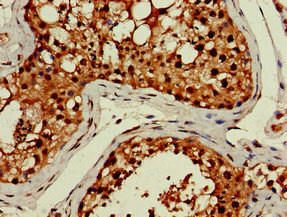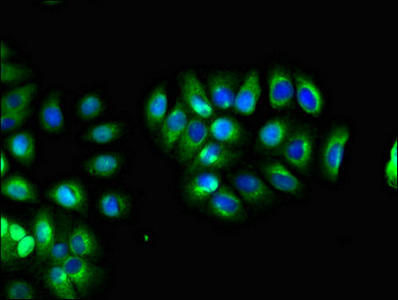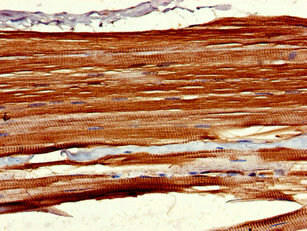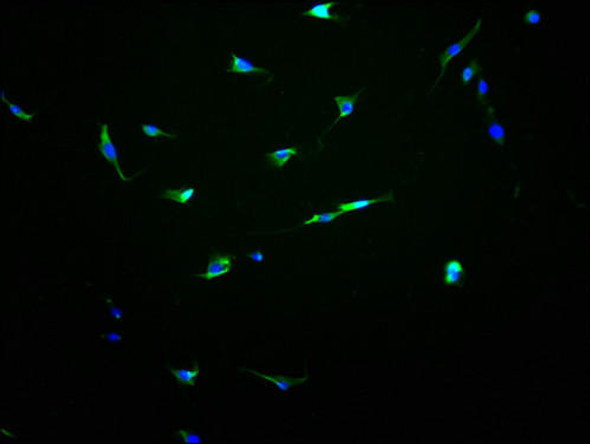Description
| Antibody Name: | LHFPL5 Antibody (PACO52642) |
| Antibody SKU: | PACO52642 |
| Size: | 50ug |
| Host Species: | Rabbit |
| Tested Applications: | ELISA, IHC, IF |
| Recommended Dilutions: | ELISA:1:2000-1:10000, IHC:1:20-1:200, IF:1:50-1:200 |
| Species Reactivity: | Human |
| Immunogen: | Recombinant Human LHFPL tetraspan subfamily member 5 protein (46-99AA) |
| Form: | Liquid |
| Storage Buffer: | Preservative: 0.03% Proclin 300 Constituents: 50% Glycerol, 0.01M PBS, pH 7.4 |
| Purification Method: | >95%, Protein G purified |
| Clonality: | Polyclonal |
| Isotype: | IgG |
| Conjugate: | Non-conjugated |
 | Immunohistochemistry of paraffin-embedded human testis tissue using PACO52642 at dilution of 1:100. |
 | Immunofluorescent analysis of A549 cells using PACO52642 at dilution of 1:100 and Alexa Fluor 488-congugated AffiniPure Goat Anti-Rabbit IgG(H+L). |
 | Immunohistochemistry of paraffin-embedded human skeletal muscle tissue using PACO52642 at dilution of 1:100. |
| Background: | In the inner ear, may be a component of the hair cell's mechanotransduction machinery that functionally couples PCDH15 to the transduction channel. Regulates transducer channel conductance and is required for fast channel adaptation (By similarity). |
| Synonyms: | LHFPL tetraspan subfamily member 5 protein (Lipoma HMGIC fusion partner-like 5 protein) (Tetraspan membrane protein of hair cell stereocilia), LHFPL5, TMHS |
| UniProt Protein Function: | LHFPL5: May function in hair bundle morphogenesis. Defects in LHFPL5 are a cause of deafness autosomal recessive type 67 (DFNB67). DFNB67 is a form of sensorineural hearing loss. Sensorineural deafness results from damage to the neural receptors of the inner ear, the nerve pathways to the brain, or the area of the brain that receives sound information. Belongs to the LHFP family.Protein type: Membrane protein, integral; Membrane protein, multi-passChromosomal Location of Human Ortholog: 6p21.31Cellular Component: apical plasma membrane; integral to membrane; stereocilium bundle tipBiological Process: ion transport; auditory receptor cell stereocilium organization and biogenesis; detection of mechanical stimulus involved in sensory perception of soundDisease: Deafness, Autosomal Recessive 67 |
| UniProt Protein Details: | |
| NCBI Summary: | This gene is a member of the lipoma HMGIC fusion partner (LHFP) gene family, which is a subset of the superfamily of tetraspan transmembrane protein encoding genes. Mutations in this gene result in deafness in humans, and a mutation in a similar gene in mice results in deafness and vestibular dysfunction with severe degeneration of the organ of Corti. It is proposed to function in hair bundle morphogenesis. [provided by RefSeq, Jul 2008] |
| UniProt Code: | Q8TAF8 |
| NCBI GenInfo Identifier: | 32698930 |
| NCBI Gene ID: | 222662 |
| NCBI Accession: | NP_872354.1 |
| UniProt Secondary Accession: | Q8TAF8,B3KX66 |
| UniProt Related Accession: | Q8TAF8 |
| Molecular Weight: | 24,201 Da |
| NCBI Full Name: | tetraspan membrane protein of hair cell stereocilia |
| NCBI Synonym Full Names: | lipoma HMGIC fusion partner-like 5 |
| NCBI Official Symbol: | LHFPL5 |
| NCBI Official Synonym Symbols: | TMHS; DFNB67; dJ510O8.8 |
| NCBI Protein Information: | tetraspan membrane protein of hair cell stereocilia |
| UniProt Protein Name: | Tetraspan membrane protein of hair cell stereocilia |
| UniProt Synonym Protein Names: | Lipoma HMGIC fusion partner-like 5 protein |
| Protein Family: | Tetraspan membrane protein of hair cell stereocilia |
| UniProt Gene Name: | LHFPL5 |
| UniProt Entry Name: | TMHS_HUMAN |






